Last week I showed Torito (bull) masks from Guatemala. In this dance, the bull dancers interact with Vaqueros (cowboys). However, many of the masks worn by the Vaqueros are also used in La Danza de la Conquista (the Conquest dance), which portrays the invasion of Indian Guatemala by a conquistador,Pedro Alvarado, along with his Spanish soldiers. As if that is not sufficiently confusing, some of the same masks are sometimes worn for the Moros y Cristianos dance (the Moors and Christians) and similar masks are used in the Venado (deer) dance. Those masks that could represent either Vaqueros or Conquistadors (or deer hunters) will be the subject of today’s post.
My discussion of these masks and their various roles will begin with a dramatic mask of Pedro Alvarado, with rosy cheeks. The leader of the Vaqueros, in the Toritos dance, wears virtually the same mask, but with a less menacing expression. In other words, a more neutral mask than this example could easily be used for both dances, while this one would be a stretch as a Vaquero.
Because Alvarado is such a heroic (or infamous) figure in the history of Guatemala, the mask worn by this character may seem particularly desirable. Joel E. Brown has noticed that we collectors have a tendency to promote our masks to the highest rank possible, wishing for example to call every yellow haired Spaniard by Alvarado’s name (2008 Volume 1, pages 1-8). Brown has learned that the Alvarado masks are marked by carved features that depict frowning. You encountered this feature in my post about the Patrón and Patrona masks that are used in the Patzcar dance; the white faced masks have swirling brows or hair but those with red or brown faces are marked by carved frowns (July 27, 2015. Also see Brown- Portfolio 2009, pp. 54-57). Well, note the V-shaped carved ridges over the round holes for vision; this mask has those carved frown lines, so this is indeed likely to represent Alvarado.
I purchased this mask from the Cavin Morris Gallery in 1995. The height is 10 inches, the width is 6½ inches, and the depth is 4 inches; this is a large mask, as one might have expected for such an important dance figure.
This mask has had heavy use. There is no morería mark. If one looks closely at the sides, these appear to be lighter in color than the central area of the back, as if the back was re-carved. Such renovation may have erased a morería mark. Sometimes such erasures were deliberate, Joel Brown has stated.
You may recall that a morería is a business establishment that creates and then rents out masks and costumes for use in Guatemalan dances. Here are some contemporary photos of masks on display in morerías, courtesy of Jay Vannini. Many of these masks were offered for use in the Conquista and Torito dances.
Here is a small group of masks from the Morería Santo Tomas in Chichicastenango, Guatemala. Some of these have been carved but not yet painted.
Here is a smaller group from the same morería. The mask worn by Alvarado is in the center, flanked on the left by a mask for a Spanish soldier (danza del Conquista), and on the right by an Indian leader from the Conquista dance, Tecún Umán.
And here is a vast selection from the Morería Alejandro Tistoj y Hijos in San Cristóbal, Totonicapán.
There are enough masks hanging from the rafters to oufit several dance groups simultaneously!
Next I will show another worn and impressive mask of Alvarado; this one is from a private collection. It has been stripped of several layers of house paint and then carefully scraped to reveal what appear to be the original colors. This mask could date to the beginning of the twentieth century or even earlier.
This is a fine old mask of Alvarado, elegantly carved. No grimace is necessary to convey the power of this formidable conquistador.
Note the delicate carving of the sideburns and the ear.
The back demonstrates obvious age and wear. The glass eyes are held in place with Cera Negra (black wax). There are two morería marks, both from San Cristóbal Totonicapán, Guatemala. ET identifies the mask as the property of Eugenio Tistoj Santiago, who died in 1930, while the conjoined AP reveals that his son, Pedro Antonio Tistoj Mazariegos, inherited the mask and continued to offer it for rental use: he died in 1978.
Here is another mask that was originally meant to portray Alvarado. However it was subsequently repainted to portray an Indian warrior instead. Note the carved frown lines above the vision openings and the small glimmers of gold in the hair where the later paint has flaked away. I bought this mask from the Cavin Morris Gallery in 1995 .
Also note the remarkably delicate carving of the hair, sideburns, ears, and nose.
At one time this mask split down the center, and was patched together with twine and hardware. Note the string tied around the bridge of the nose through the vision openings. This mask is 7½ inches tall, 6 inches wide, and 4½ inches deep.
From the back view the line of breakage is readily apparent, as are the pairs of repair bolts at the top and bottom and the string lashing the vision holes together. One can also see that this mask has had extensive use.
Here is a fourth mask from the Conquest dance that began as Alvarado and was later repainted to depict an Indian. In its Alvarado form it would have readily served in the Toritos dance as one of the lead Vaqueros. On this example the former gold color of the hair, sideburns, mustache, and beard is more easily seen. The frown lines above the bridge of the nose are also prominent. I bought this mask from the Cavin Morris Gallery in 1995. It is a great old mask, but not as finely carved as the one above.
Note the stylized carving of the goatee. The tip of the left side of the mustache had broken off and was not repaired, long ago.
The inset glass eyes are also long gone. This mask is 8 inches tall, 7 inches wide, and 4 inches deep.
The patina on the back of this mask is very dark. There is no morería mark.
Here is a fifth mask in this style. This may be a mask of Alvarado, but the frown lines above the nose are so subtly carved that one might settle for calling this a mask for a Spanish soldier. It is much smaller than the first mask in this post, reinforcing the impression that it might not be Alvarado. However, when I obtained this mask from Spencer Throckmorton in 1996, he expressed the opinion that these rather small masks represent an earlier style and that they are probably older. Can you see the faint frown lines on this handsome mask?
This mask is exquisitely carved. It measures 7 inches tall, 6 inches wide, and 3½ inches in depth.
This mask has a morería mark—ET, which is visible on the upper left side of the back. The script E has been partly scraped away while the T is fully intact. As noted earlier, the ET mark belonged to Eugenio Tistoj, whose morería was in San Cristóbal, Totonicapán. According to Luis Luján Muñoz (Máscaras y Morerías de Guatemala, page 120), Eugenio lived c. 1855-1930, so this mask dates from that period.
Here is another one of those smaller masks. Unfortunately, this one lacks a morería mark. An alternative explanation for this smaller size is that these were masks for children. This is another example of a design that would appear in the Conquest dance with pink face and gold hair, but in its present form it is probably a Vaquero.
I bought this mask from Spencer Throckmorton in 1995.
This mask is 7 inches tall, 5 inches wide, and 3 inches deep.
The back shows extensive staining from long use.
Here is a similar mask that could be worn by a Vaquero in the Toritos dance or by a Spaniard in the Conquest dance. I bought this mask from the Cavin Morris Gallery in 1995 .
This mask is 7¼ inches tall, 6½ inches wide, and 5¾ inches deep.
This is an extremely old mask with many layers of paint, which have fallen off on the bottom of the chin.
This mask has a double morería mark. On the left it has MC, on the right, 596. MC was the mark of Miguel Chuc, of San Miguel Totonicapán. Miguel died in 1935, according to Luján.
Here is another old mask of this style. The hair is carved with tiny curls. I got this mask from Spencer Throckmorton in 1995; he called it a Moor. With the benefit of Brown’s photos (2008, Volume 1), one can confidently call it a Spaniard (page 104) or a Vaquero (page 150).
Like the last, this mask too carries many coats of paint. There is a cracked area of the hair above the right eye where some of the paint has been lost, revealing a spot that is bright gold, in contrast to the duller surfaces around that area. In fact the hair on the right temple appears to be coated with silver paint. The paint on the face is dirty and worn.
This mask is 7 inches tall, 6 inches wide, and 4¼ inches deep.
The chin area on the back of this mask is old and worn while the temples seem much lighter, as if re-carved. The strap seems relatively new. There is no morería mark.
Next is a mask of a wounded warrior; he has probably represented a Conquistador and then an Indian, depending on his paint. Without the red diagonal stripe he would have also been suitable as a Vaquero. I bought this mask from Spencer Throckmorton in 1996.
The finely carved hair is evident in this side view.
This mask is 8 inches tall, 6½ inches wide, and 3½ inches deep.
This back is worn, but also very dirty.
The next mask could have been either an Indian in the Conquest dance or a Vaquero. There is a similar mask in Brown 2008 (Volume 1, page 144), which he identified as a Negrito in the Toritos dance. The present mask appears to have been repainted as a Negrito, but underneath one can see that the skin was pink, with red cheeks. I bought this mask from David Espinosa in 2001.
The new coat of paint on the face is wrinkled as if it did not bond with the earlier coat. The paint on the hair and mustache has an older patina, suggesting that those elements were not repainted. This last coat makes the mask look much newer than is actually the case. This is quite a handsome mask as both the hair and the mustache were carved in an older style; this (wonderful) hair is not unlike that of the first Alvarado and the mustache resembles that on the earlier mask with the tiny golden curls. The nose is also nicely shaped. Although the present skin color makes one think of the masks worn by Mexicano dancers, the hair of those masks is carved in another style. What I don’t see is any trace of gold paint on the hair or mustache. All this favors the probability that this was originally an Indian in the Conquest dance, but one that was repainted to be a Vaquero or a Mexicano. As Brown has told us, masks are not always what they seem to be.
This mask is 7½ inches tall, 6¾ inches wide, and 4 inches deep.
The back appears to have only moderate staining from use, but the sides appear to have been re-carved. Based on the carving of the face, I believe that this mask is older than the back would suggest. The original eyes, which are long gone, may have been held in place with gesso (plaster).
The last mask in today’s post is an obvious Vaquero for the Toritos dance, but it resembles the mask worn by a Spanish soldier in the Conquest dance. I bought this mask from Bob Ibold (masksoftheworld.com) in 2006.
In the Conquest dance, such a mask would have a pair of relief-carved birds on the forehead instead of these flowers.
This mask is 7½ inches tall, 6½ inches wide, and 3¾ inches deep.
There are at least two sets of initials carved on the back, DO and SH. Both sets may refer to former owners or dancers, however Brown (2008, Volume 2, page 635) showed another mask that was marked twice with the SH brand; he wondered if this was an unknown morería mark. The back has excellent age and the left eye has been reset with plaster or filler, while the right eye is traditionally set with black wax.
Next week we will examine a few masks that are more specific for the Conquest dance.

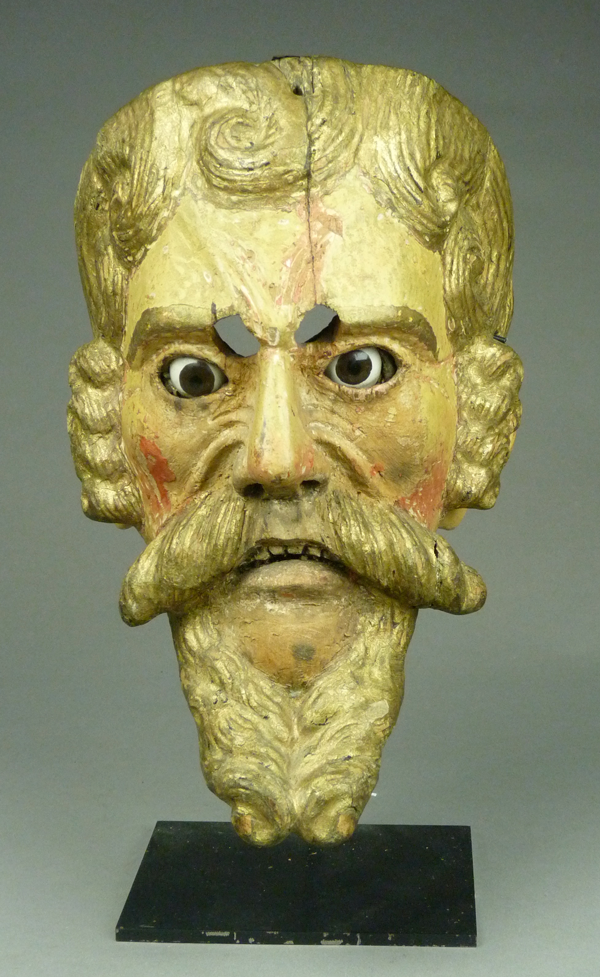
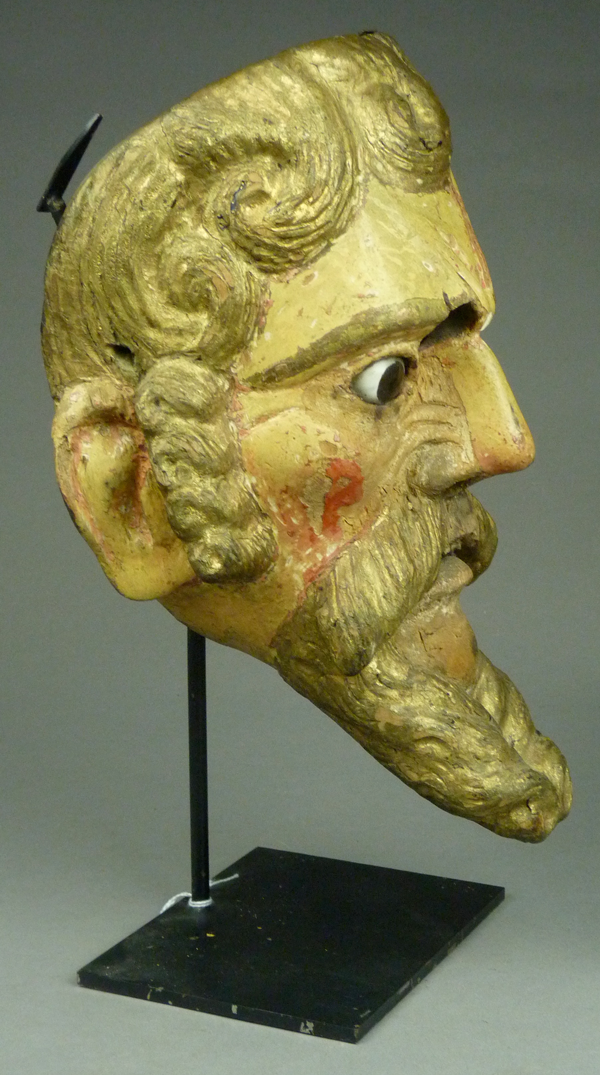
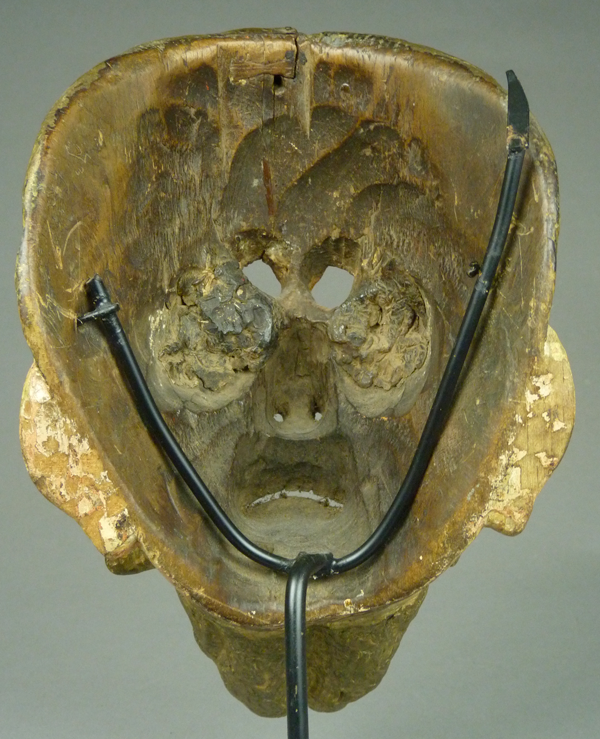
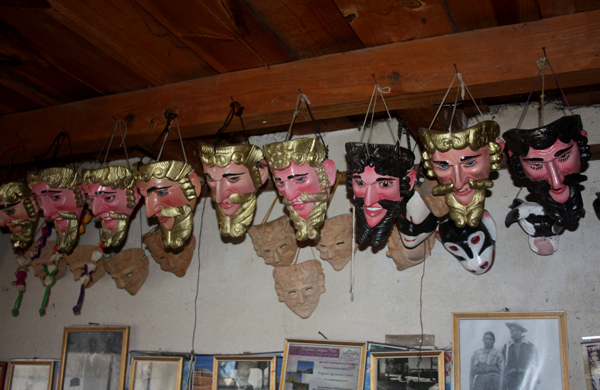

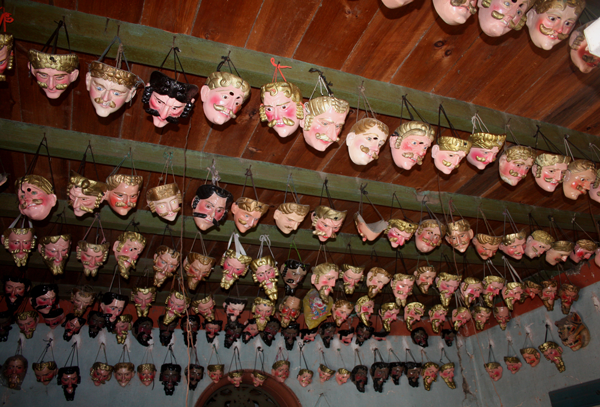
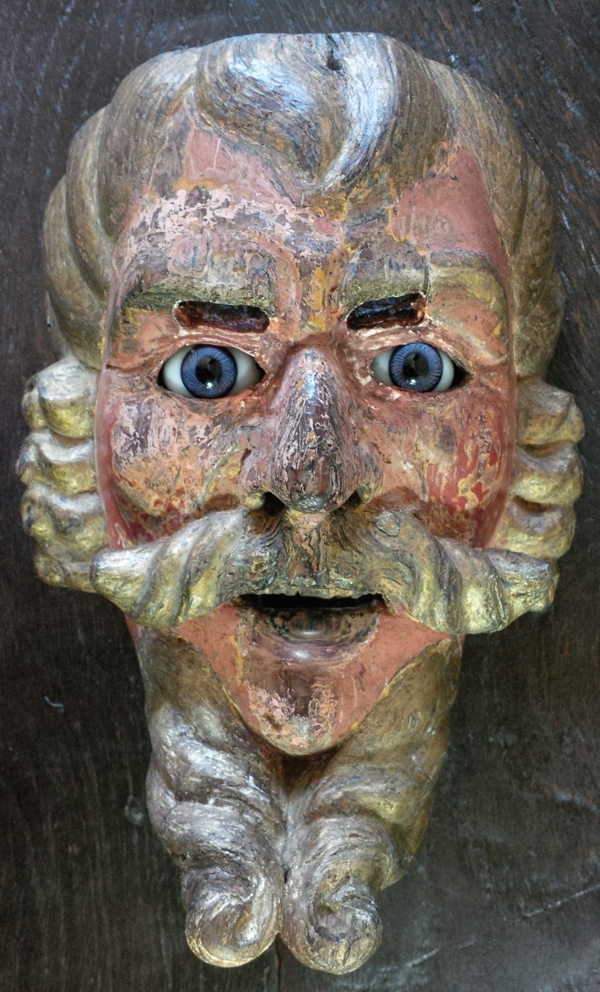
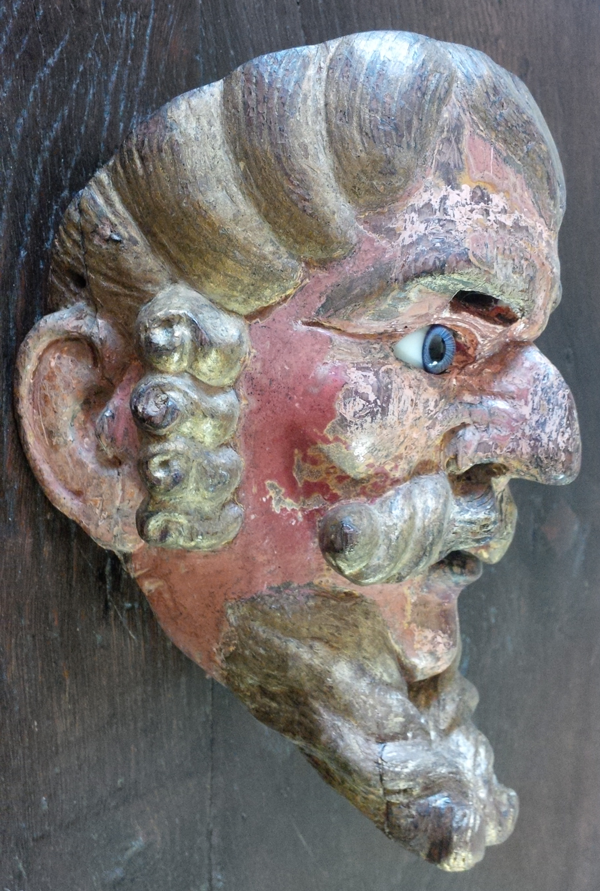
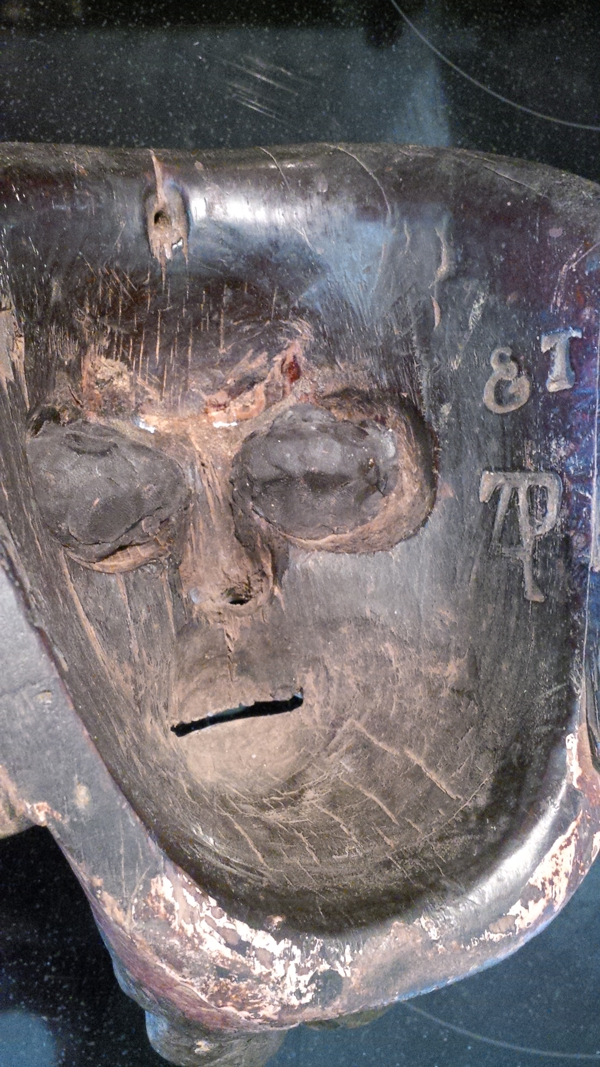
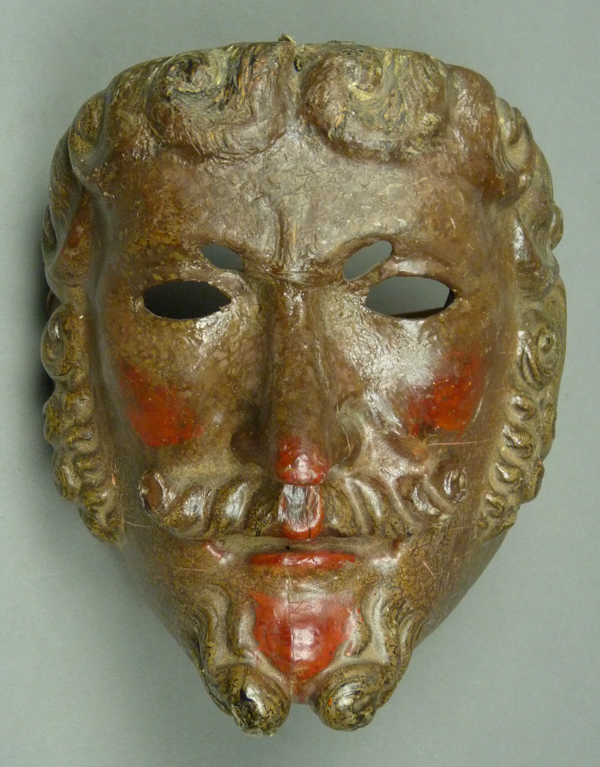
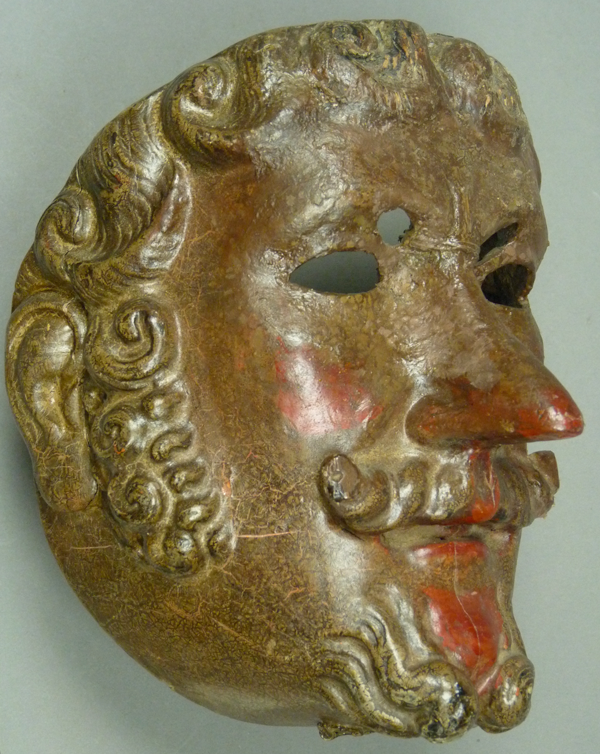

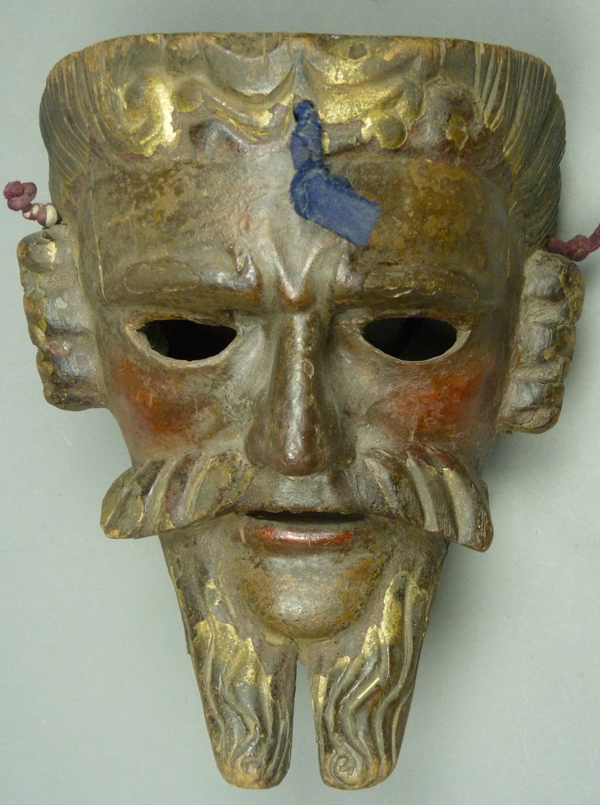
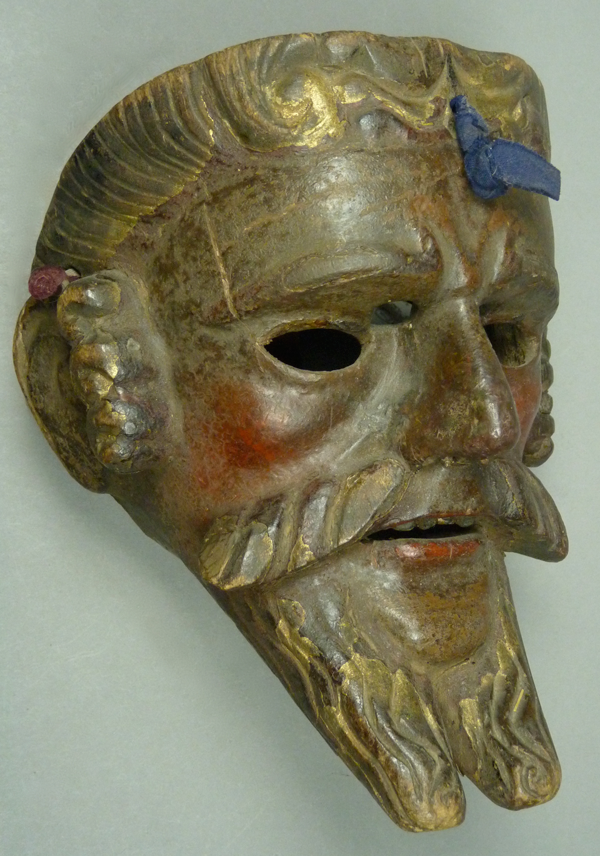
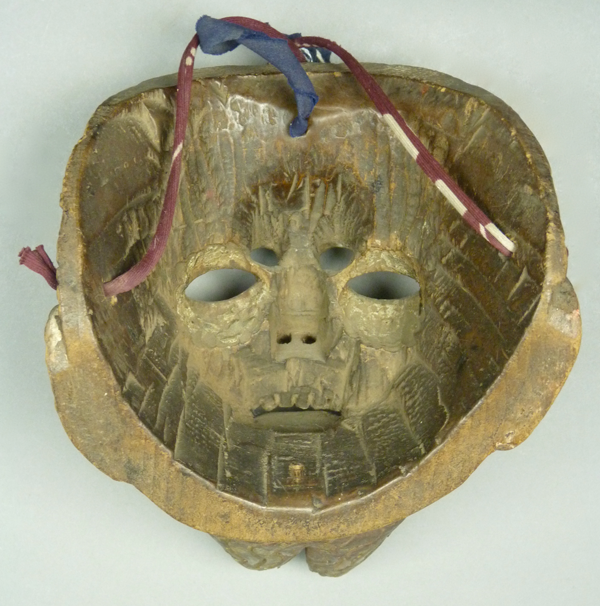
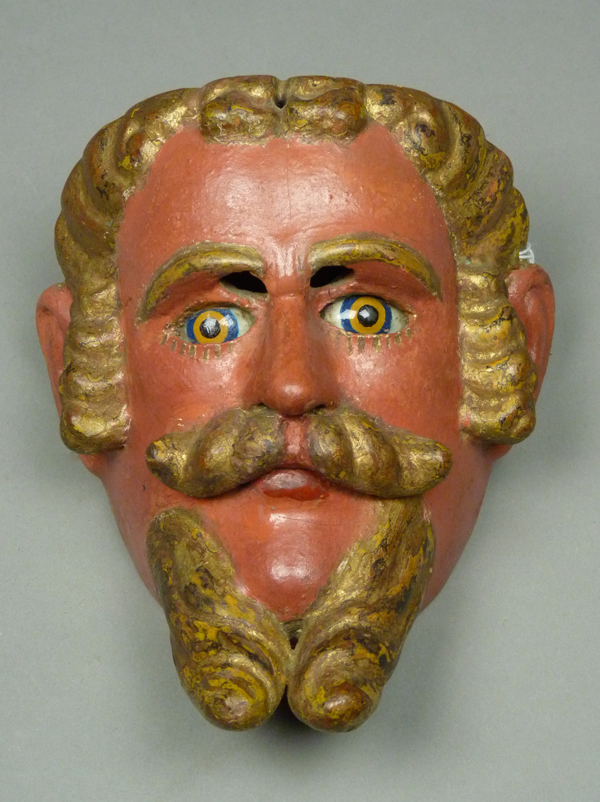
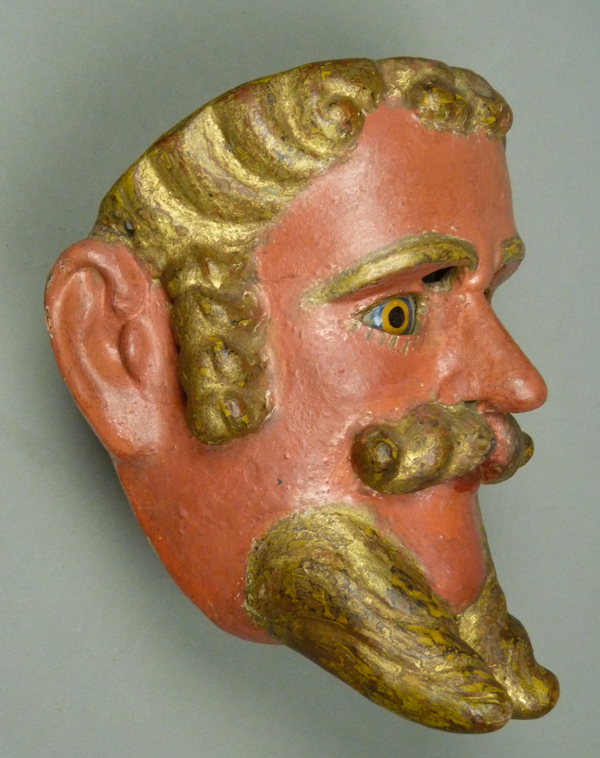
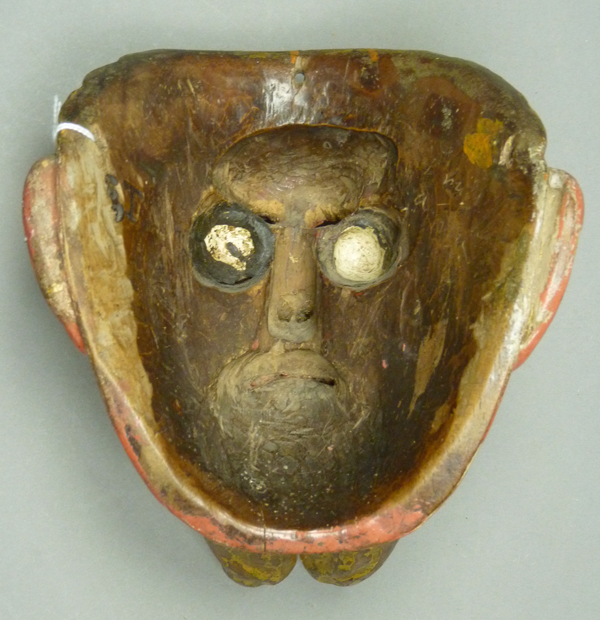


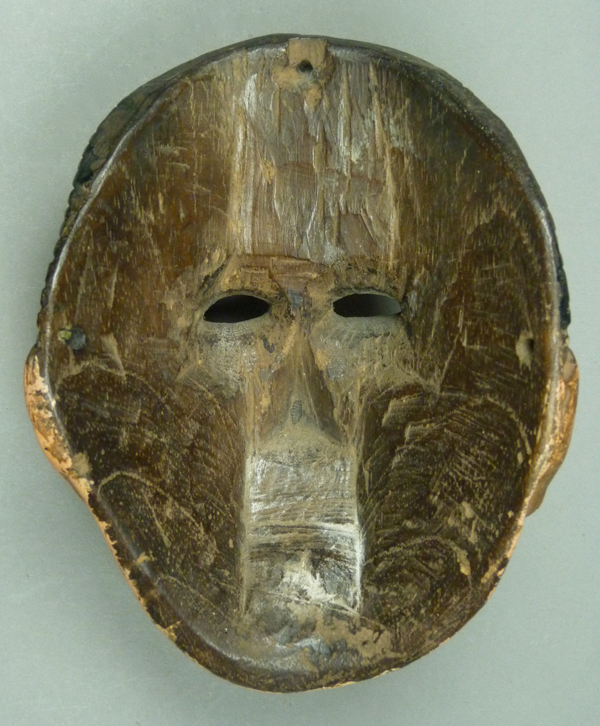

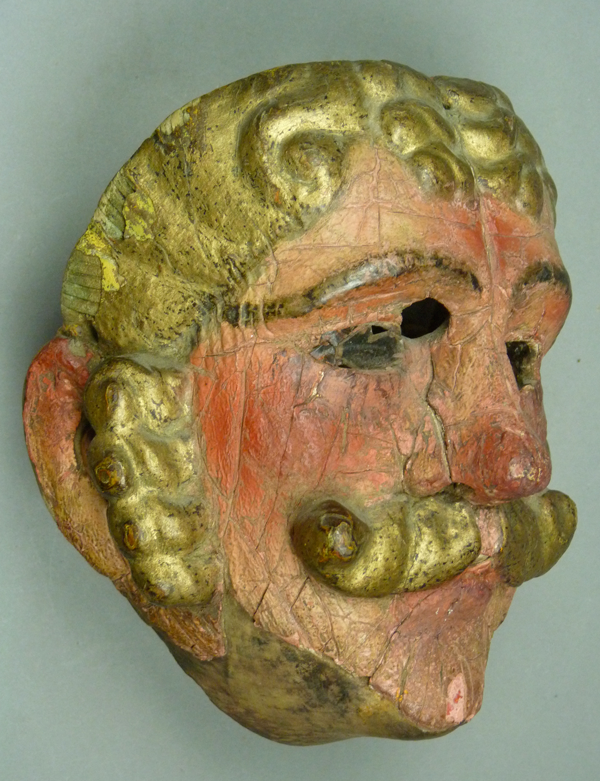

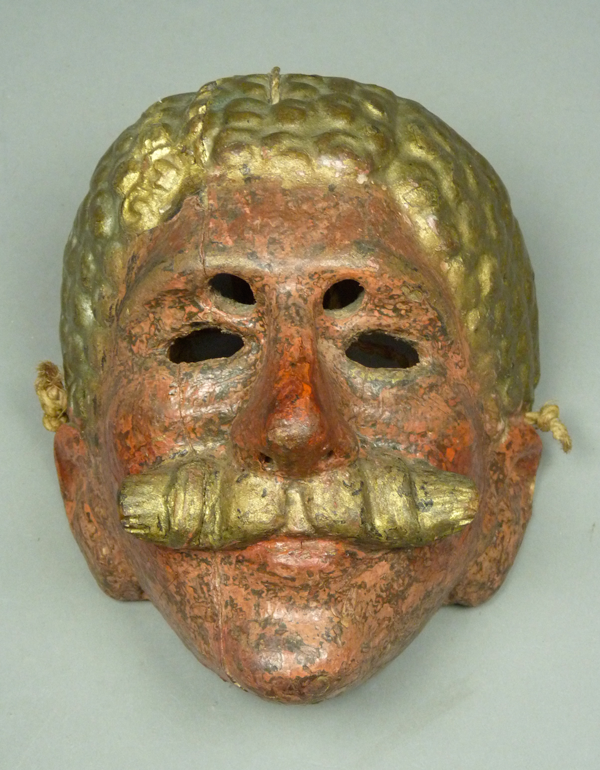
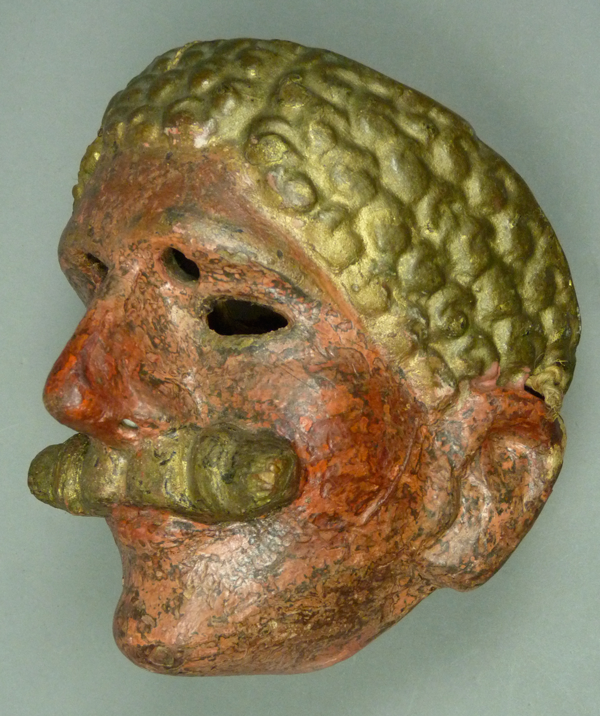
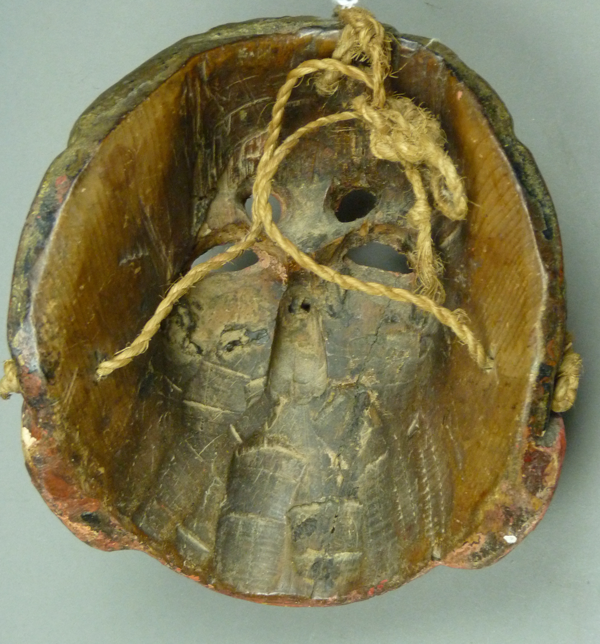
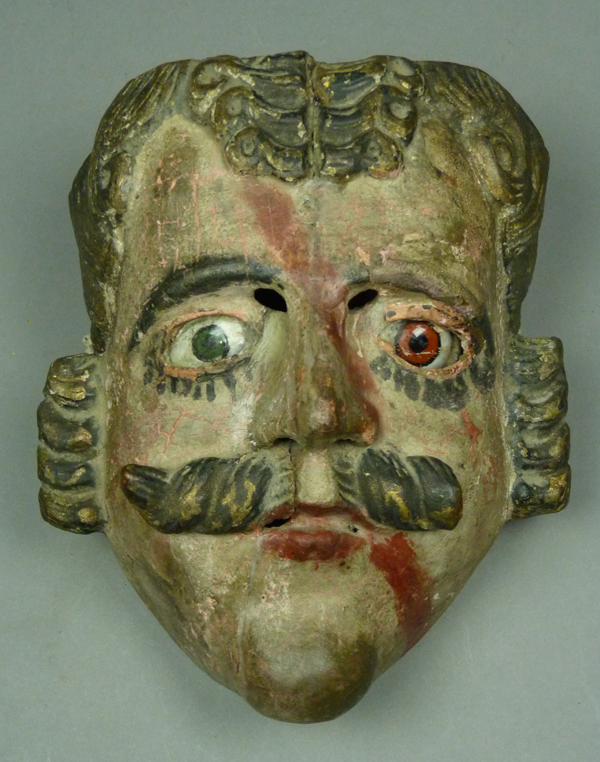
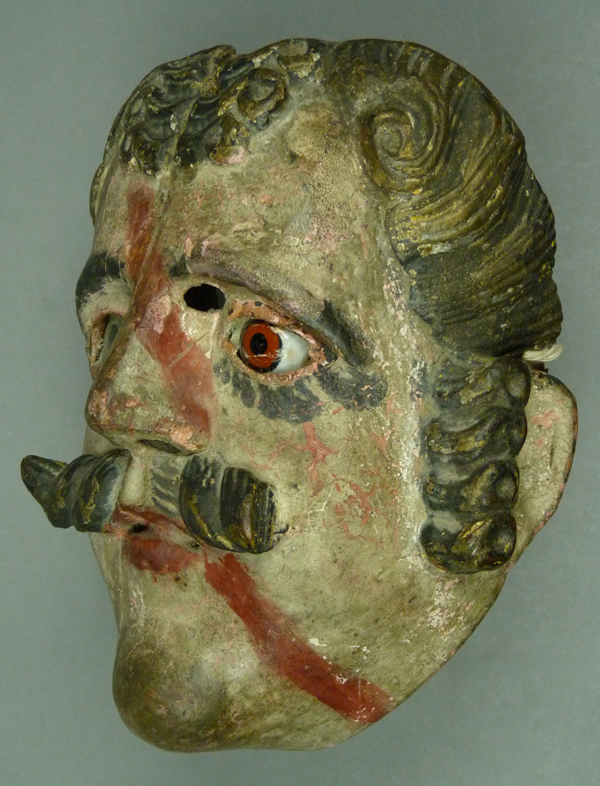
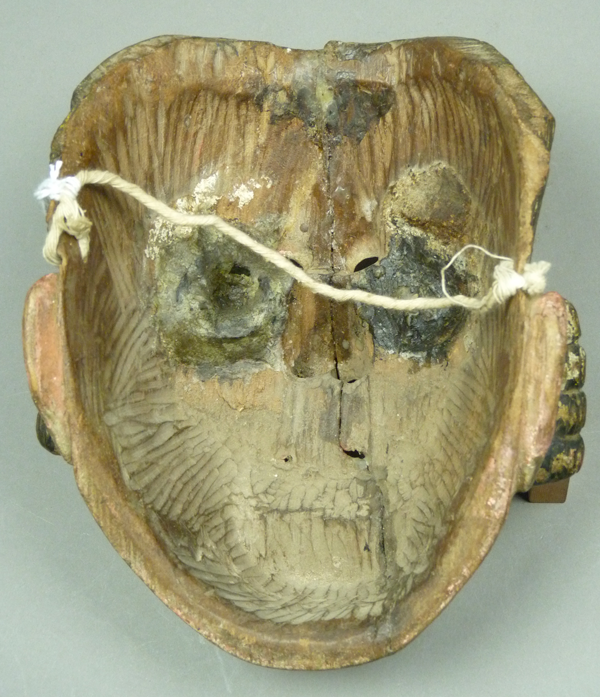
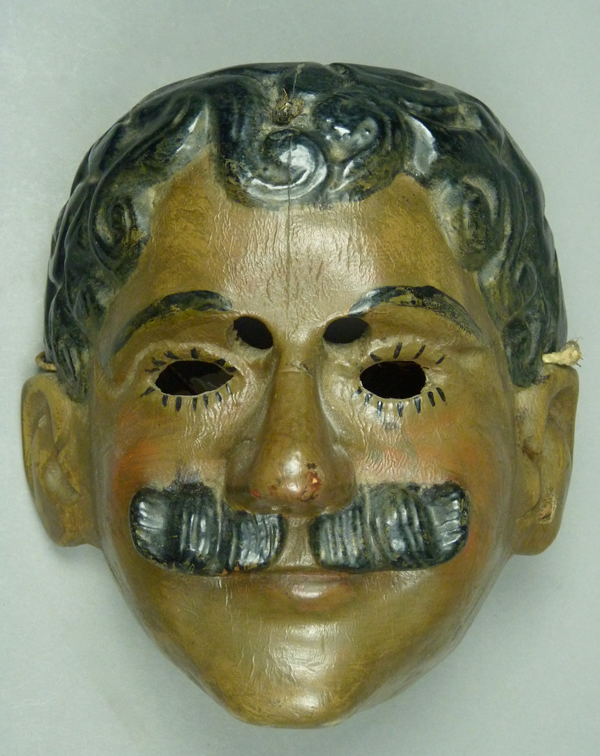
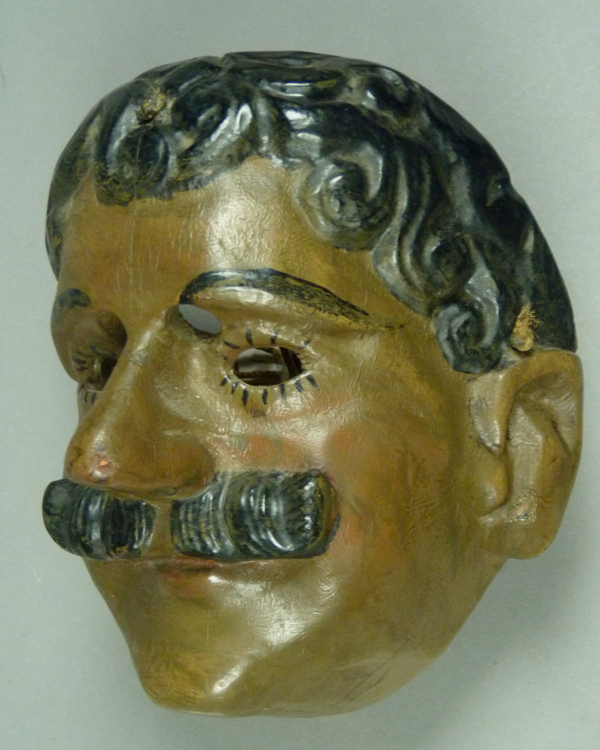

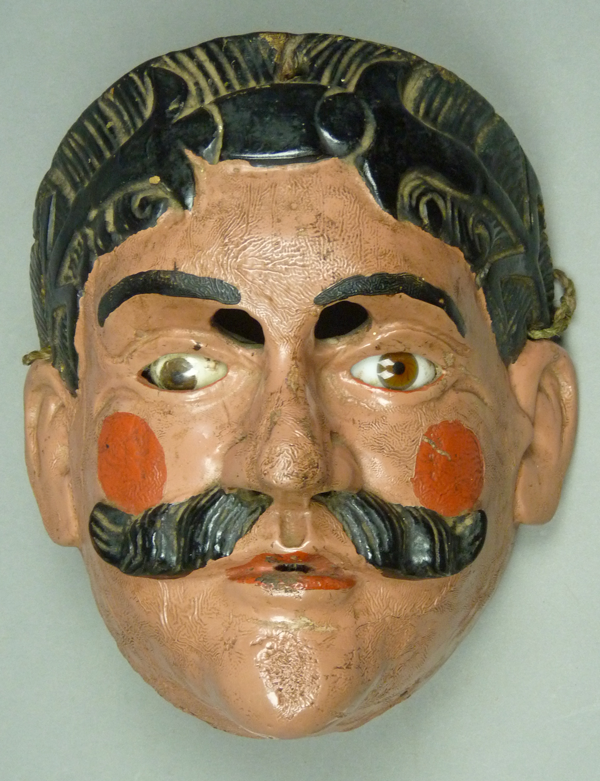
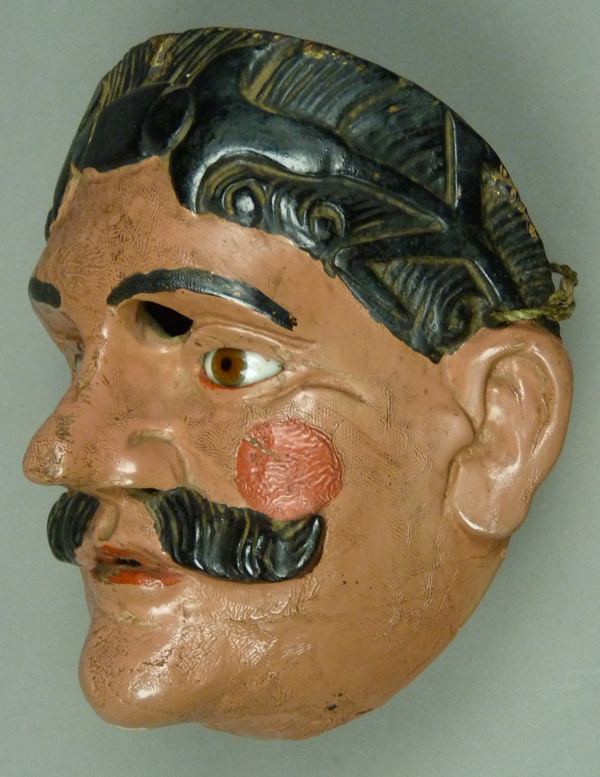
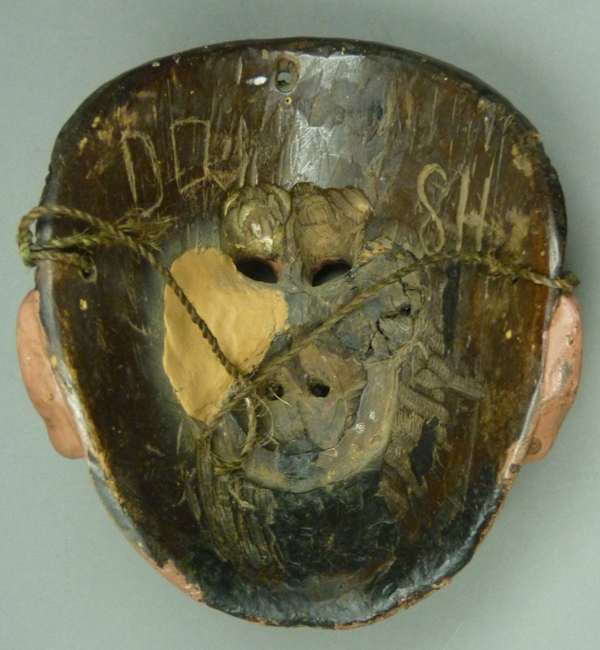
Dear Bryan,
Somewhere in your text you say that Lujan wrote that Miguel Chuc died in 1935. Lujan was wrong. First, the last page of Barbara Bode’s 1961 paper on the ‘Conquista’ shows a page of the account book of the Chuc moreria from 1939 with Miguel Chuc’s unmistakable signature. But more important, Chuc died in 1944 according to both his death certificate (shown on page 621 of ‘Masks of Guatemalan Traditional Dances’ in the section titled Miguel Chuc Biography)and the inscription on his tombstone in the Chuc family tomb in the Toto cemetery.
Please add my name to your emailing list.
Cheers,
Joel
Wow! Thanks for all the great info! I just found a mask like these today at an estate sale. It is more primitive looking and smaller, but has same characteristics and frown. Like some of these it is painted black and has gold showing thru. I would love to send you pic to get your opinion. Thanks again and keep up the good work!